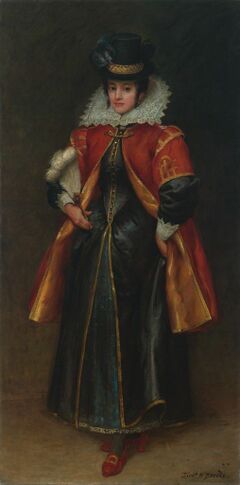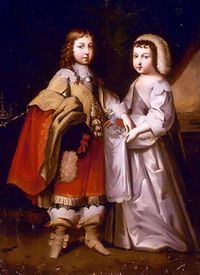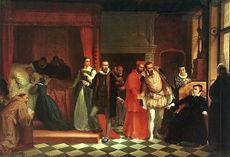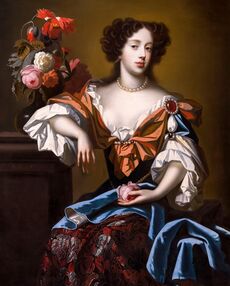Lorena of Cascadia
|
| |||||||||||||||||
Lorena Christina Cascadia, (13th of Owyn’s Flame, 1714 - 6th of Tobias' Bounty, 1767) born Laurentina Julia and alternatively known as Lorena of Augustin, was the only daughter to Duke Romulus Horen of Cascadia and his wife, Anabel I of Curonia. As the sister of two reigning emperors of Holy Oren, Lorena was Princess Imperial throughout her eldest brother’s reign, and held the most definite claim to Oren after her twin brother, John VII, abdicated not shortly after the eldest did; she would become the last Princess of the Cascadian Dynasty after her brother was proclaimed as missing indefinitely. Lorena would commit herself to the empire through her involvement in the city government, taking the mantle of First Lady of the Exchequer in the year 1735, which allowed her to preside over the ever changing body of the City Council of Helena as a point of continuity.
Her coordinated marriage to the heir pretender of the deposed Empire of Man, Antony Helane, produced a daughter with an uncontested claim to both Holy Oren and Man, which came into usage when Lorena was elevated to Empress-consort upon Antony's ascension as Peter III, Holy Orenian Emperor in the year 1737, later becoming the longest-serving empress-consort of Oren to date with a tenure of thirty years.
It would take 78 years for another empress consort to rise in Oren, a time during which four would-be empresses would be divorced, dead, or widowed before their husband's ascension to the throne. These happenings were attributed to the furious spirit of Empress Lorena damning the imperial family, being called the Consort Curse.
Contents
Early years and adolescence
Born minutes before her twin Achilius to Imperial Prince Romulus, Duke of Cascadia, and his wife, the then Queen of Curonia, Anabel Devereux, Lorena was bestowed with the high imperial name of Laurentina Julia on the 13th of Owyn's Flame, emulating the style of past pertinaxi princesses in their flexian naming. The twins' imperial birth was witnessed by all those who graced the walls of the Rubrummagnus on that most beauteous day in the year of 1714.
War of Two Emperors
The strife of the War of Two Emperors immediately led to Horen loyalists elevating Laurentina's elder brother, Godfrey, to a new throne as the Emperor of Renatus in order to destroy Joseph Marna's chances to reform the Holy Orenian Empire under House Marna. As a direct result of the war's conflicts, Laurentina took up constant studying at the age of 6 as a means of entertainment, taking interest in the acquisition of culture and language. Both were taught to her by a mix of her mother, Anabel, her sister in law Empress Adeline, and Adeline's mother (the Princess of Alstion) Vivienne's teachings, three ladies who would evolve to become her closest confidantes. She spent most of her time alongside the older trio, with the exception of time spent with twin brother Achilius, which regularly consisted of despot banter that was resolved only at the behest of their mother. Regardless, the two showed a unique bond, described only as one developed from the womb itself.
Laurentina acclaimed the orenian title of Princess Imperial upon Renatus' victory in the war, when it would adopt its defeated enemy's name as the 8th iteration of the Holy Orenian Empire. On the 11th of Owyn's Flame, 1720, she along with Achilius were baptized by Frederick Guillen, the Bishop of Pembroke, to symbolize their unwavering faith in the righteousness of GOD, and his salvaging of the Horenic dynasty. Laurentina later witnessed her eldest brother Godfrey's abdication unto Achilius, whose name was then changed to John as Holy Orenian Emperor in the year 1723.
Brother's Abdication
Laurentina had only turned 10 after the war was over, and was finally free to travel without fear of capture. Her mother, who'd recently become the minister of foreign affairs, assigned to her a task to record the exploits of all foreign courts on behalf of the empire. Laurentina, adept in each vassals' culture and language due to her studies, readily agreed. Her first (and last) travel was in the year 1724, and was to the Duchy of Westmarch, where she would remain for but a saint’s week. From Westmarch, she was informed of John's decision to abdicate from the imperial throne, additionally disowning himself from the House of Cascadia and granting himself the title of Duke of Augustin. She witnessed the sudden death of the ladies of her youth, Adeline and Vivienne, as well as that of her father, Romulus.
No longer a princess, she was forced to become matriarch of the house of Cascadia at the tender age of 11, abandoning her tour of the empire, while being advised by the Duke of Westmarch away from any brash movements, causing her to wallow irremediably. Her childhood was undeniably in a state of despair, causing her to adopt a dulled, cold-blooded demeanor for the majority of her teenage years.
Upon her return to the city of Helena, Laurentina was christened with the name “Lorena Christina” in order to assume the new Johannian regality, and was to remain in the Imperial Palace, stripped of all her titlings and royalty. She was destined to life as a simple noblewoman of the court.
Matriarch of Cascadia
Lorena was discouraged from imperial affairs with the exception of days spent with her cousin Vespira, as well as the niece of the newly crowned Emperor Alexander II, Julia Alstion. She remained in the palace until she neared 15 years old, when she'd receive a letter from her bastard brother, Marcus de Rubrum, who beckoned her to a private council concerning the disappearance of Lorena's legitimate brothers and the status of their respective fiefs. The product of this meeting was that Lorena was aptly promoted to become the matriarch of Cascadia, succeeding the absent John in his fief. It was additionally proclaimed that she would then be known as 'of Cascadia', the final Imperial Princess of the Imperium Renatum.
It was decided by Marcus that Lorena would embark on a visit to the lands of Aeldin, from where she would allow a council of Horen ancestors to assess her right of existence. Here, she'd be introduced to her grandmother, the aged former empress of Man, Helen Horen. Helen presented Lorena with the bearings of a red sash knitted by Princess Ophelia Horen, Helen's sister-in-law. Lorena, seeking gentility, chose to then adorn the sash of Ophelia as a symbol of her titular ascension. She'd return to the court of Emperor Alexander II, turning now to the comforts of the aforementioned Julia Alstion, who aided her in becoming involved in the courts.
Under the Lord Protectorate ; 1731-1737
Government
In the year 1731, a Lord Protector was chosen as the leader to Holy Oren from among it's vassals when it was discovered that Alexander II was not in fact of Horenic origins, but instead a bastard of the dastardly Empress-Mother Cesarina. Lorena had for a time been close friends with said Lord Protector's wife, Mariya Barbanov, due to the Barbanovi woman frequenting the Imperial Court as the wife of a large vassal. Through Mariya's close connections, Lorena met the likes of the Secretary of Interior, Peter de Vitus (P.Vitus), and the Secretary of the Treasury, Peter de Sarkozy (P.Sarkozy), who she'd offer various pieces of advice in matters of scripture and documentation, things she'd heavily studied in her solitary youth. P.Vitus, especially, provided her a platform for movement that she'd use to later balance both their offered positions.
It was during the city of Helena's shift from it's high imperial alternative to a more Carrion-resonant architectural style that P.Vitus first offered her to become the Head Steward of Helena, which would later evolve into the title of First Lady of the Exchequer when the city, and thus the city government, was finalized. In the position, she'd preside mainly over property, taxation, and urban design, as well as the financial sectors of the city government, which directly entailed to what P.Sarkozy offered her as his second-in-command, otherwise known as Deputy Secretary of the Treasury, though she would largely drift away from the department of the treasury upon P.Sarkozy's resignation in 1737.
As First Lady, she presided over every city council assembly within the new elective government of the city of Helena, being the single constant in the ever changing political atmosphere of the board of Ward Liverymen. This entrusted her with the task of managing the city's lawmaking body beside the elected Lord Mayor. When P.Vitus had leisurely stepped away from the forefront of affairs concerning the interior, Lorena was obligated to assume a majority of his responsibilities, being temporarily placed as the head of the interior until the crown selected a successor to the position of Secretary.
Contest for marriage
Immediately following the Lord Protector's rise, Lorena was summoned by her distant cousin, Titus Tiber, the Prince of Beaufort. He'd omit to her an idea concerning the marriage of her to Charles, the Prince of Alstion; he was the same man who'd contested the Lord Protector as a claimant to the imperial throne. Titus stated it was for the purpose of uniting the lines of Horen. Lorena, hesitant yet much obliged, agreed.
It was not a year later that Marcus de Rubrum reappeared, urging Lorena to marry her cousin; he was the firstborn son of the deposed emperor Antonius of Man, bearing the name Antony Sigismundic. This idea had been drafted by Marcus de Rubrum, he had seen the toll his father's relatives had taken on him and did not want his sister following a similar path to their father. Lorena, having created an acquaintance in Charles, was appalled at Marcus' petition. Charles asked her to run from Oren to the renatian-infested Morsgrad, where he stated they'd be wed secretly. However, Lorena had by then built for herself a people to guide in the Department of the Interior, so she was forced to accept Marcus' proposal in order to remain within Oren.
Lorena and Antony Sigismundic Helane were married on a summer's day in 1734, within the cathedral of St. Adrian in the city of Ves, where Antony had for a time been protected by the friendship of the King of Kaedrin. Being cousins, Lorena insisted they keep their distance after the wedding, and was even quoted by attendants as stating that she'd "never been placed in such an awkward position in her life." Despite this, they'd go on to produce two daughters to carry on the imperial bloodline: Anne Augusta, the first ever heiress of Oren, and Lorena Antonia, a Countess by Marriage into House Helvets.
Holy Orenian Empress; 1737-1767
After inhibiting dreary symptoms of a fatal disease, Lord Protector Adrian immediately scripted his will in the Instrument of Coronation, a letter deeming Lorena's husband, Antony Sigismundic, the true and rightful heir to the throne of Oren. Upon Adrian's death nearing the end of 1737, Antony was crowned in a glorious baptism and coronation ceremony, thereby taking a new regal name as Peter III, Holy Orenian Emperor. By default as Peter's wife, Lorena was suddenly risen as Holy Orenian Empress-consort beside him, much to her surprise.
Lorena was horribly unprepared to take up the mantle of first lady of the Empire, and therefore sought advice from Queen Milena of Haense, who’d then held a long and effortless tenure as Queen. They spoke on the subject of righteous queenship under the subjugation of the ever-prevalent male force, and Milena advised her that her power would never be absolute, but borrowed from her husband’s jurisdiction. She was quoted as saying that “to attain any sort of importance, one must believe themselves important, and force others to acknowledge their importance with fleeting words of consequence.” Lorena was horrified by the brutal reality granted to her by the Haeseni Queen, and would distance herself majorly from the atmosphere of the stereotypical consort of ‘pomp and femininity’, preferring to continue her work on the city council. She made strong friendships in the men of the Imperial Privy and the denizens of Helena, despite an unchanging impertinent attitude. Ultimately, her tenure extended over the city of Helena, with little care for those beyond the walls of the capital, excepting the enemies that would soon rear their faces.
“It isn’t for me - the life of glamour. I was born with everything, lost it all, and regained it after decades of solemnity. Yet... it seems the only fulfillment I’ve had in life was the reward of toil and exertion that was my position as the Lady Exchequer. It was the only thing I’ve ever truly earned, and the only thing I’ve ever truly loved.” -Empress Lorena to Duchess Mariya of Adria in confidence, recorded by a busybody handmaiden.
Start of the Rubern War; 1740-1760
Just as Peter rose to power, so too did a force of opposition set entirely against the idea of an empire, which encompassed various external nations: the Alliance of Independent States (or AIS), a coalition lead by the Duchy of Morsgrad (a successor to Norland), which was hellbent on disrupting the unified and centralized power of Holy Oren. Amidst the chaos, Lorena began to oversee the construction of homesteads along the walls of Helena. One day as she meandered out of the city gates to ponder the possibilities for remodeling the bay of Helena, she was suddenly faced by a squadron of Morsgradi soldiers which had been ravaging the roads of Oren in search of men to hold ransom. Both parties stood momentarily in awe of the impossible coincidence, but regardless Lorena was taken hostage in front of her very own home, and carried to a cell underneath the city of Rubern, where she was interrogated by the Duke of Morsgrad, Godric. Despite the nature of her captivity, she was more-or-less easy going and held tender conversation with Godric. Many say it was the empress’ relaxed demeanor which would later lead to her quiet and undisturbed release, whilst others have rumored the involvement of the Morsgrad-affiliated Prince of Alstion, whose previous betrothal to Lorena had left him with unending responsibility and affection towards the young lady, thus ensuring his plead for her freedom.
However, whilst Lorena chatted with the enemy, the empire and the AIS erupted into various skirmishes as search parties were sent after her. One of these skirmishes succeeded in capturing Peter III, and landed him trapped beside the mocking Lorena. The disgruntled emperor hardly acknowledged her, leaving her to speak with Godric’s wife- and her cousin-, the Duchess Eleanor. Just hours later, the Morsgradi soldiers removed Peter without any warning of their intention, forcing Lorena to watch helplessly as he was dragged away from her. She was made to walk into the gates of Helena with chains at her feet, and a mind plagued with the possibility of her husband’s premature death. Days later, Peter was ominously returned to the Palace of Helena in dire condition, possibly having succumb hours of torture. He and Lorena refused to speak for an entire month following the incident.
Plot for Curonia
Having overcome the first year of war, Lorena decided to remain domestically-inclined to keep herself distracted despite the limits on travel. Finally, she resolved to settle into her defacto position as the head of the Court of Novellen, though recruiting various ladies to aid her in the endeavor, as she harbored general distaste for the matters of court and ‘ladylike’ regulation. Her eyes were then busied with the downpour of documents that flew in and out of the palace, all until she came across a poster openly declaring the lamentations of her distant cousin, Ester Devereux, against the defective ex-vassal of the empire: Curonia.
Lorena was intrigued; she realized Ester’s innumerable influence within Curon, as the Devereux princess herself was just a hand’s reach away from being the primary heir to the once-great kingdom. The empress quickly hatched a plan that would have upheld Ester as a pretender to Curonia against the disloyal standing Regent who had opted out of the empire at the very mention of war, and returned Curonia into the fold of the empire if successful, thus strengthening the power of Oren against its’ newfound foes. The two ladies convened in secrecy within the Palace of Novellen, and in just days the drafts of their plan were laid out bare for the imperial privy to witness. Letters were sent between the Privy and the regent of Curon which rightfully removed him of his right to hold the prestigious office, and doubly declared his cowardice in the face of war.
After a succession of private meetings, the Orenian Privy Council convinced the Regent to step down on the grounds of treason, and dutifully rewarded Ester with the title of “Governor-General of Curonia” as payment. This resulted in a new era for Oren: that of the Protectorates. After Ester’s untimely demise years laters, the Kingdom of Curonia would become a titular name for Peter III to wield alongside the illustrious title of emperor, following thereafter with the revocation of the ‘Kingdom of Kaedrin’ in favor of another Protectorate. This pre-destined chain of events set off by Lorena’s quick attention began the rule of Peter III as the first emperor to truly centralize his reign.
The Empress' Trial
“And the council cowers in the comforts of their lavish apartments- apartments bestowed unto them by the tireless labor of men who’ve now cost their lives fighting a war of pointless ambition. Surrender is not an option, no, but a plethora of words fueled by little action speaks ‘surrender’ in volumes. My impish husband, GOD forgive me, has suffered this truth.” -Lorena to Queen Milena, when discussing the state of the war..
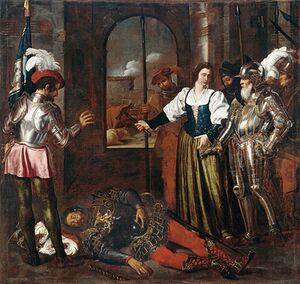
Years following the beginning of the war, Oren and the AIS seemed at a neverending stalemate. The AIS ravaged the land and terrorized Orenian citizens, yet the leadership of Oren refused to yield to those who they imprecated as ‘barbaric heathens’ who sought nothing but the collapse of humanity. Lorena watched as the world fell into another cycle of war, yet she refused to justify the means for another conflict squeezing the very essence of life and joviality from her, just as it had in her youth. However, an announcement came that challenged this stance and raddled her to her very core: the capture of her most beloved and youngest daughter, Lorena Antonia, as she returned to Helena from prayer at the Cloud Temple. Lorena watched as the men around her, frightened and reluctant, batted their eyes and reasoned that “they’ll have to release her someday”, or that “rescuing her will only weaken our forces”. The stalwart empress refused to allow war to take another thing from her, and in the greatest defiance, she penned a letter to Antonia’s captives, pleading to exchange herself with her 5 year old brood. They readily accepted.
See: The Empress' Trial
The announcement of the trial made waves in Oren, and dozens of bands began to plot for a way to quietly free the empress before the event could transpire. On that day, the ranks of Oren’s military intelligence would hold an emergency meeting that would decide the actions of the now famously revered “Operation: Lady in the Hightower.” It would oversee the freeing of Empress Lorena with precise and calculated movements made under the cover of complete darkness, and would almost be thwarted by the sudden appearance of a Ruberni princess, but was only made althemore successful when it was revealed that the princess, Aleksandra Mariya of Rubern, was an Oren-sympathizer who would later go on to denounce her people entirely. With the operation successful, Empress Lorena would return home to both her daughters safe and sound, and would even happily embrace her husband (a thing unheard of). She suffered no beration from the privy about her decision, and was even praised by some for her enduring courage and trust in the intelligence of Oren to outwit the guards of Rubern.
See: Lady in the Hightower
Death and Burial
Perhaps the natural process of aging or the stress of captivity took its toll on the empress, for alongside aching, shivers, and burning headaches, she no longer held her usual fervor. For some time, these symptoms culminated in her bones but were ignored by Lorena in favor of a new court reform project that she sought to implement. This remained the same up until her sudden collapse just hours before a court session was to be held. The court physician was beckoned, and he recommended that the Empress discontinue all imperial duties and distance herself from the public eye, for it was detrimental to her waning health. Lorena whined incessantly about the ordeal, but nevertheless, she was made to pass on her court duties to her right-hand-lady, Valentina Ruthern. The once staunch woman now laid without remedy within the Palace of Novellen, doing naught but speaking to too-young handmaidens on fragile subjects that perhaps went over their heads.
Almost as soon as the resting period had started, she had begun discussing her soon-to-be decrepit life with Archchancellor Simon Basrid. He suggested alcoholism to fill the void of her days, and though Lorena had hardly ever touched a bottle in her life, she reasoned that there would be nothing better to do. Simon granted her the acquisition of various crates of rums and imported haeseni wines to be used as fuel for her lonesome nights. One fateful night, a few years into this chain of private debauchery, it is said that the empress’ inebriation enraged GOD himself, and he sent her unknowingly tumbling over the balcony of her chambers and subsequently below to her death. There’s also secondary speculation that, tired of a heedless life, the Empress merely autodefenestrated. The third wonders if she wasn’t pushed after having said something extraordinarily evil to a lady in wait, as was habitually routine for the ellusive madame.
Regardless of the truth, Lorena’s body was found at the moat opposite the balcony of the empress’ quarters, a bottle of Carrion Black fallen just feet beside her. She died the 6th of Tobias’ Bounty, 1767, at 53 years old, and was buried modestly in the Palace’s courtyard, with much lamentation and sorrow from the relationships she’d left behind.
Legacy
Various rumors encircle the melancholy life of the rueful empress: from her unhappy marriage, to her brooding addiction to work, to her vexation with the decisions of Oren during the Rubern War. All helped cement her as a generally dissatisfied empress, though stalwart and iron-willed. She was a Queen impassioned with her capital and her family, and little with the vassals surrounding it. Some swore they’d seen her ghost tormenting the trees along the bay of Helena, before she disappeared into the bay herself.
Following Lorena’s death, Peter would forsake his marriage entirely and take up a public mistress, cementing their matrimony as one of absolute dissociation. It is often said that they both took on a plethora of secondary lovers in order to remain sane within their loveless marriage, though gossip swirls that Lorena had always remained in loving contact with Charles Alstion despite her marriage, and left a majority of her belongings to him in her death. However, her closest friends described Lorena as “completely removed from the subject of love,” all of them refusing to believe that she had ever truly harbored feelings for any single person. Consequentially, Lorena left her most treasured possession, the Sash of Ophelia, to her closest friend, Julietta Varoche, who would later pass it on to Lorena’s daughter, Anne Augusta, the future first Holy Orenian Empress-regnant.
The Consort Curse
Another Empress consort would not exist in Oren for almost a century after Lorena due to various circumstances including the failed marriage of John VIII and the deaths of Philip II and Crown Prince Philip's wives: Judith of Rochefort and Amadea of Pompourelia, respectively, and later the death of the Crown Prince before he could ascend with his new wife, Charlotte of Aldersberg. Many began to perceive this as Lorena's spirit cursing the Imperial Dynasty with the cheerlessness of her own marriage, and it would be whispered of as The Consort Curse. In that century, many girls would be born with unique iterations of her name in the hope that the Empress' spirit would be satiated. There were Lorenas, Lorinas, Laurenes, Laurentinas, etc, strewn across humanity. However, aside from her natural fame as a premier consort of Oren, the Empress' true life story was largely lost to history until the emergence of the Rosemoor Convention for Women's Rights, during which the nature of womanhood and consortry was extremely scrutinized, driving people to investigate the woeful marriage of the last Empress they'd known in so long as an example of woman's disenfranchisement.
After the victory of the Aster Revolution by Prince Philip Amadeus, the Empire was finally rewarded with a new Empress consort beside him, Anastasia of Kositz. Many assumed this was because the state of Anastasia's ascension as a revolution appeased Lorena's spirit, for it was an act of rebellion against the increasingly derelict institution of the imperial family.
Titles, styles, honours and arms
- 1714-1721 Her Imperial Highness, Princess Laurentina of Cascadia
- 1715-1717 Her Imperial Highness, Princess Laurentina of Cascadia, Princess of Curonia
- 1721-1724 Her Imperial Highness, the Princess Imperial
- 1729–1767 Her Imperial Highness, the Duchess of Augustin, Last Princess of the Imperium Renatum
- 1737–1767 Her Imperial Majesty, the Holy Orenian Empress
Full Title as Holy Orenian Empress
Her Imperial and Royal Majesty, Lorena, Holy Orenian Empress consort, Queen consort of Curonia, Renatus, Kaedrin, and Salvus
Issue
Lorena and Peter III produced two children: Holy Orenian Empress, Anne I, and Princess Lorena Antonia (named for her mother and father both).
| Name | Birth | Death | Marriage | Notes |
|---|---|---|---|---|
| Anne I | 12th of Owyn's Flame, 1735 | 20th of Horen's Calling, 1800 | Joseph II | Firstborn child of Peter and Lorena. Princess Imperial and Heiress to the Holy Orenian Empire. |
| Lorena Antonia Helane | 13th of Godfrey's Triumph, 1740 | Alive | Richard Victor Helvets, Count of Rochefort | Second born child of Peter and Lorena. Countess-Consort of Rochefort & Imperial Princess of the Holy Orenian Empire. |
| Ancestors of Lorena of Cascadia | ||||||||||||||||||||||||||||||||||||||||||||||||||||||||||||||||||||||||||||||||||||||||||||||||||||||||||||||||||||||||||||||||||||||||||||||||||||||||||||||||||||||||||||||||||||||||||||||||||||||||||||||||||||||||||||||||||||||||||||||||||||||||||||||||||||||||||||||||||||||||||||||||||||||||||||||||||||||||||||||||||||||||||||||||||||||||||||||||||||||||||||||||||||||||||||||||||||||||||||||||||||||||||||||||||||||||||||||||||||||||||||||||||||||||||||||||||||||||||||||||||||||||||||||||||||||||||||||||||
|---|---|---|---|---|---|---|---|---|---|---|---|---|---|---|---|---|---|---|---|---|---|---|---|---|---|---|---|---|---|---|---|---|---|---|---|---|---|---|---|---|---|---|---|---|---|---|---|---|---|---|---|---|---|---|---|---|---|---|---|---|---|---|---|---|---|---|---|---|---|---|---|---|---|---|---|---|---|---|---|---|---|---|---|---|---|---|---|---|---|---|---|---|---|---|---|---|---|---|---|---|---|---|---|---|---|---|---|---|---|---|---|---|---|---|---|---|---|---|---|---|---|---|---|---|---|---|---|---|---|---|---|---|---|---|---|---|---|---|---|---|---|---|---|---|---|---|---|---|---|---|---|---|---|---|---|---|---|---|---|---|---|---|---|---|---|---|---|---|---|---|---|---|---|---|---|---|---|---|---|---|---|---|---|---|---|---|---|---|---|---|---|---|---|---|---|---|---|---|---|---|---|---|---|---|---|---|---|---|---|---|---|---|---|---|---|---|---|---|---|---|---|---|---|---|---|---|---|---|---|---|---|---|---|---|---|---|---|---|---|---|---|---|---|---|---|---|---|---|---|---|---|---|---|---|---|---|---|---|---|---|---|---|---|---|---|---|---|---|---|---|---|---|---|---|---|---|---|---|---|---|---|---|---|---|---|---|---|---|---|---|---|---|---|---|---|---|---|---|---|---|---|---|---|---|---|---|---|---|---|---|---|---|---|---|---|---|---|---|---|---|---|---|---|---|---|---|---|---|---|---|---|---|---|---|---|---|---|---|---|---|---|---|---|---|---|---|---|---|---|---|---|---|---|---|---|---|---|---|---|---|---|---|---|---|---|---|---|---|---|---|---|---|---|---|---|---|---|---|---|---|---|---|---|---|---|---|---|---|---|---|---|---|---|---|---|---|---|---|---|---|---|---|---|---|---|---|---|---|---|---|---|---|---|---|---|---|---|---|---|---|---|---|---|---|---|---|---|---|---|---|---|---|---|---|---|---|---|---|---|---|---|---|---|---|---|---|---|---|---|---|---|---|---|---|---|---|---|---|---|---|---|---|---|---|---|---|---|---|---|---|---|---|---|---|---|---|---|---|---|---|---|---|---|---|---|---|---|---|---|---|---|---|---|---|---|---|---|---|---|---|---|---|---|---|---|---|---|---|---|---|---|---|---|---|
|
|
||||||||||||||||||||||||||||||||||||||||||||||||||||||||||||||||||||||||||||||||||||||||||||||||||||||||||||||||||||||||||||||||||||||||||||||||||||||||||||||||||||||||||||||||||||||||||||||||||||||||||||||||||||||||||||||||||||||||||||||||||||||||||||||||||||||||||||||||||||||||||||||||||||||||||||||||||||||||||||||||||||||||||||||||||||||||||||||||||||||||||||||||||||||||||||||||||||||||||||||||||||||||||||||||||||||||||||||||||||||||||||||||||||||||||||||||||||||||||||||||||||||||||||||||||||||||||||||||||

